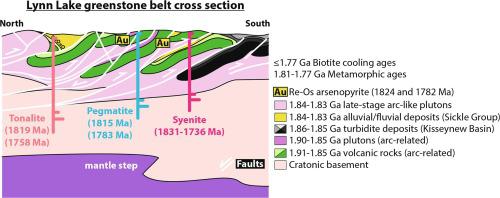当前位置:
X-MOL 学术
›
Ore Geol. Rev.
›
论文详情
Our official English website, www.x-mol.net, welcomes your
feedback! (Note: you will need to create a separate account there.)
Sedimentary basin controls on orogenic gold deposits: New constraints from U-Pb detrital zircon and Re-Os sulphide geochronology, Lynn Lake greenstone belt, Canada
Ore Geology Reviews ( IF 3.2 ) Pub Date : 2020-11-01 , DOI: 10.1016/j.oregeorev.2020.103790 C.J.M. Lawley , X.M. Yang , D. Selby , W. Davis , S. Zhang , D.C. Petts , S.E. Jackson
Ore Geology Reviews ( IF 3.2 ) Pub Date : 2020-11-01 , DOI: 10.1016/j.oregeorev.2020.103790 C.J.M. Lawley , X.M. Yang , D. Selby , W. Davis , S. Zhang , D.C. Petts , S.E. Jackson

|
Abstract Sedimentary basins that open and close during the last stages of mountain building represent an important exploration criterion for orogenic gold deposits. However, the genetic and/or preservation controls of these synorogenic, or “Timiskaming-type”, sedimentary basins and their controlling fault systems on orogenic gold deposits remain unclear. Herein we address that knowledge gap and report new U-Pb detrital zircon and Re-Os sulphide (arsenopyrite and pyrite) geochronology and sulphide Pb isotope results for the Paleoproterozoic Lynn Lake greenstone belt (LLGB), Manitoba, Canada. The youngest detrital zircon from all six meta-conglomerate and -psammite samples of the synorogenic Sickle Group, and previously reported U-Pb zircon ages for post-Sickle Group intrusions, are used to constrain its depositional timing from 1836 ± 15 to 1831 ± 4 Ma. Replicate analyses of one highly-radiogenic arsenopyrite sample from an auriferous vein at the MacLellan gold deposit yield a weighted average Re-Os model age of 1824 ± 12 Ma, which is identical to previously published in situ U-Pb xenotime ages at the same deposit (1827 ± 8 Ma). Each of these hydrothermal ages demonstrate that early-stage auriferous veins immediately post-date deposition of the Sickle Group and most likely occurred prior to peak metamorphism (1814–1801 Ma). This sequence of events is very similar to the Abitibi greenstone belt, suggesting that a synorogenic phase of extension and rapid burial of auriferous veins by Timiskaming-type Sickle Group sediments may have played an important genetic and/or preservation control on early-stage gold mineralization in the LLGB. However, unlike the Abitibi greenstone belt, none of the known gold deposits within the LLGB are hosted within the Sickle Group. Younger Re-Os model arsenopyrite ages at 1782 ± 16 Ma from the MacLellan gold deposit also post-date synorogenic sedimentary basins by ca. 50 Myr. These late-stage auriferous veins are unrelated to the synorogenic extensional phase and more likely reflect repeated fluid focusing along reactivated structures during a post-peak metamorphic phase of hydrothermal activity. The multi-stage hydrothermal history of orogenic gold deposits in the LLGB also provides a possible explanation for the mixture of depleted mantle-like and highly radiogenic fluid components that are inferred from age-corrected sulphide Pb isotope compositions (µ1.8 Ga = 8.9–10.6). Reworked cratonic margins and their associated greenstone belts thus represent favourable depositional settings for auriferous fluids at multiple stages throughout the lifespan of an orogen.
中文翻译:

造山带金矿床的沉积盆地控制:来自加拿大林恩湖绿岩带 U-Pb 碎屑锆石和 Re-Os 硫化物地质年代学的新限制
摘要 造山后期开合的沉积盆地是造山型金矿床的重要勘探标准。然而,这些同造或“提米斯卡明型”沉积盆地及其控制造山带金矿床的断层系统的成因和/或保存控制仍不清楚。在此,我们解决了这一知识空白,并报告了加拿大马尼托巴古元古代林恩湖绿岩带 (LLGB) 的新 U-Pb 碎屑锆石和 Re-Os 硫化物(毒砂和黄铁矿)地质年代学和硫化物 Pb 同位素结果。来自同生镰刀群的所有六个变质砾岩和砂岩样品中最年轻的碎屑锆石,以及先前报道的镰刀群后侵入体的 U-Pb 锆石年龄,用于将其沉积时间限制在 1836 ± 15 至 1831 ± 4 Ma。对来自 MacLellan 金矿含金矿脉的一个高放射性毒砂样品的重复分析产生了 1824 ± 12 Ma 的加权平均 Re-Os 模型年龄,这与先前发表的同一矿床的原位 U-Pb 磷钇矿年龄相同(1827±8 毫安)。这些热液年龄中的每一个都表明早期含金脉在镰刀组的沉积之后立即出现,并且最有可能发生在峰值变质作用之前(1814-1801 Ma)。这一系列事件与 Abitibi 绿岩带非常相似,这表明 Timiskaming 型 Sickle Group 沉积物的含金脉的延伸和快速埋藏的同生相可能对 LLGB 早期金矿化起到了重要的成因和/或保存控制。然而,与 Abitibi 绿岩带不同的是,LLGB 中已知的金矿床都没有位于 Sickle 组内。来自 MacLellan 金矿床的 Younger Re-Os 模型毒砂年龄为 1782 ± 16 Ma,也是由约 50 密尔 这些晚期含金静脉与共生伸展阶段无关,更可能反映了在热液活动的峰值后变质阶段期间沿重新激活结构的重复流体聚集。LLGB 中造山金矿床的多阶段热液历史也为从年龄校正的硫化物 Pb 同位素组成(μ1.8 Ga = 8.9– 10.6)。因此,改造后的克拉通边缘及其相关的绿岩带代表了造山带整个生命周期中多个阶段的含金流体的有利沉积环境。
更新日期:2020-11-01
中文翻译:

造山带金矿床的沉积盆地控制:来自加拿大林恩湖绿岩带 U-Pb 碎屑锆石和 Re-Os 硫化物地质年代学的新限制
摘要 造山后期开合的沉积盆地是造山型金矿床的重要勘探标准。然而,这些同造或“提米斯卡明型”沉积盆地及其控制造山带金矿床的断层系统的成因和/或保存控制仍不清楚。在此,我们解决了这一知识空白,并报告了加拿大马尼托巴古元古代林恩湖绿岩带 (LLGB) 的新 U-Pb 碎屑锆石和 Re-Os 硫化物(毒砂和黄铁矿)地质年代学和硫化物 Pb 同位素结果。来自同生镰刀群的所有六个变质砾岩和砂岩样品中最年轻的碎屑锆石,以及先前报道的镰刀群后侵入体的 U-Pb 锆石年龄,用于将其沉积时间限制在 1836 ± 15 至 1831 ± 4 Ma。对来自 MacLellan 金矿含金矿脉的一个高放射性毒砂样品的重复分析产生了 1824 ± 12 Ma 的加权平均 Re-Os 模型年龄,这与先前发表的同一矿床的原位 U-Pb 磷钇矿年龄相同(1827±8 毫安)。这些热液年龄中的每一个都表明早期含金脉在镰刀组的沉积之后立即出现,并且最有可能发生在峰值变质作用之前(1814-1801 Ma)。这一系列事件与 Abitibi 绿岩带非常相似,这表明 Timiskaming 型 Sickle Group 沉积物的含金脉的延伸和快速埋藏的同生相可能对 LLGB 早期金矿化起到了重要的成因和/或保存控制。然而,与 Abitibi 绿岩带不同的是,LLGB 中已知的金矿床都没有位于 Sickle 组内。来自 MacLellan 金矿床的 Younger Re-Os 模型毒砂年龄为 1782 ± 16 Ma,也是由约 50 密尔 这些晚期含金静脉与共生伸展阶段无关,更可能反映了在热液活动的峰值后变质阶段期间沿重新激活结构的重复流体聚集。LLGB 中造山金矿床的多阶段热液历史也为从年龄校正的硫化物 Pb 同位素组成(μ1.8 Ga = 8.9– 10.6)。因此,改造后的克拉通边缘及其相关的绿岩带代表了造山带整个生命周期中多个阶段的含金流体的有利沉积环境。











































 京公网安备 11010802027423号
京公网安备 11010802027423号